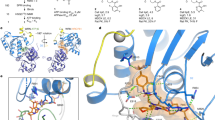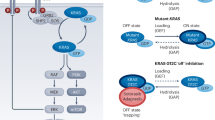Abstract
The major impediment to cure for many malignancies is the development of therapy resistance with resultant tumor progression. Genetic alterations leading to subversion of inherent apoptosis pathways are common themes in therapy resistance. Bcl-2 family proteins play a critical role in regulating mitochondrial apoptosis that governs chemotherapeutic effects, and defective engagement of these pathways contributes to treatment failure. We have studied the efficacy of BH3 peptidomimetics consisting of the minimal death, or BH3, domains of the proapoptotic BH3-only proteins Bid and Bad to induce apoptosis using neuroblastoma (NB) as a model system. We demonstrate that BH3 peptides, modified with an arginine homopolymer for membrane transduction (called r8-BidBH3 and r8-BadBH3, respectively), potently induce apoptosis in NB cells, including those with MYCN amplification. Cell death is caspase 9 dependent, consistent with a requirement for the intrinsic mitochondrial pathway. Substitutions at highly conserved residues within the r8-BidBH3 peptide abolish apoptotic efficacy supporting activity through specific BH domain interactions. Concomitant exposure to r8-BadBH3 and r8-BidBH3 at sublethal monotherapy doses revealed potent synergy consistent with a competitive displacement model, whereby BH3 peptides displace sequestered BH3 proteins to induce cell death. Further, BH3 peptides demonstrate antitumor efficacy in a xenograft model of NB in the absence of additional genotoxic or trophic stressors. These data provide proof of principle that targeted re-engagement of apoptosis pathways may be of therapeutic utility, and BH3-like compounds are attractive lead agents to re-establish therapy-induced apoptosis in refractory malignancies.
This is a preview of subscription content, access via your institution
Access options
Subscribe to this journal
Receive 50 print issues and online access
$259.00 per year
only $5.18 per issue
Buy this article
- Purchase on Springer Link
- Instant access to full article PDF
Prices may be subject to local taxes which are calculated during checkout




Similar content being viewed by others
Abbreviations
- BH:
-
Bcl-2 homology domain
- DISC:
-
death-inducing signaling complex
- PTD:
-
peptide transduction domain
References
Biedler JL, Spengler BA . (1976). J Natl Cancer Inst 57: 683–695.
Chen L, Willis SN, Wei A, Smith BJ, Fletcher JI, Hinds MG et al. (2005). Mol Cell 17: 393–403.
Cooperman J, Neely R, Teachey DT, Grupp S, Choi JK . (2004). Stem Cells 22: 1111–1120.
Cosulich SC, Worrall V, Hedge PJ, Green S, Clarke PR . (1997). Curr Biol 7: 913–920.
Dive C, Evans CA, Whetton AD . (1992). Semin Cancer Biol 3: 417–427.
Feder MK, Gilbert F . (1983). J Natl Cancer Inst 70: 1051–1056.
Green DR, Reed JC . (1998). Science 281: 1309–1312.
Hersey P, Zhang XD . (2003). J Cell Physiol 196: 9–18.
Holinger EP, Chittenden T, Lutz RJ . (1999). J Biol Chem 274: 13298–13304.
Jacks T, Weinberg RA . (2002). Cell 111: 923–925.
Keshelava N, Zuo JJ, Chen P, Waidyaratne SN, Luna MC, Gomer CJ et al. (2001). Cancer Res 61: 6185–6193.
Korsmeyer SJ . (1992). Cancer Surv 15: 105–118.
Kuwana T, Bouchier-Hayes L, Chipuk JE, Bonzon C, Sullivan BA, Green DR et al. (2005). Mol Cell 17: 525–535.
Letai A, Bassik MC, Walensky LD, Sorcinelli MD, Weiler S, Korsmeyer SJ . (2002). Cancer Cell 2: 183–192.
Letai A, Sorcinelli MD, Beard C, Korsmeyer SJ . (2004). Cancer Cell 6: 241–249.
Matthay KK, Villablanca JG, Seeger RC, Stram DO, Harris RE, Ramsay NK et al. (1999). New Engl J Med 341: 1165–1173.
Moreau C, Cartron PF, Hunt A, Meflah K, Green DR, Evan G et al. (2003). J Biol Chem 278: 19426–19435.
Nicholson DW . (2000). Nature 407: 810–816.
Nikolaev AY, Li M, Puskas N, Qin J, Gu W . (2003). Cell 112: 29–40.
Ostermeyer AG, Runko E, Winkfield B, Ahn B, Moll UM . (1996). Proc Natl Acad Sci USA 93: 15190–15194.
Reed JC . (1995). Curr Opin Oncol 7: 541–546.
Reed JC . (1999). J Clin Oncol 17: 2941–2953.
Reed JC . (2003). Cancer Cell 3: 17–22.
Reynolds CP, Biedler JL, Spengler BA, Reynolds DA, Ross RA, Frenkel EP . (1986). J Natl Cancer Inst 76: 375–387.
Schlesinger HR, Gerson JM, Moorhead PS, Maguire H, Hummeler K . (1976). Cancer Res 36: 3094–3100.
Schmechel D, Marangos PJ, Brightman M . (1978). Nature 276: 834–836.
Schmitt CA, McCurrach ME, de_Stanchina E, Wallace_Brodeur RR, Lowe SW . (1999). Gene Dev 13: 2670–2677.
Schwab M, Alitalo K, Klempnauer KH, Varmus HE, Bishop JM, Gilbert F et al. (1983). Nature 305: 245–248.
Soengas MS, Capodieci P, Polsky D, Mora J, Esteller M, Opitz-Araya X et al. (2001). Nature 409: 207–211.
Sutherland RM . (1988). Science 240: 177–184.
Tajiri T, Liu X, Thompson PM, Tanaka S, Suita S, Zhao H et al. (2003). Clin Cancer Res 9: 3345–3355.
Teitz T, Wei T, Valentine MB, Vanin EF, Grenet J, Valentine VA et al. (2000). Nat Med 6: 529–535.
Tumilowicz JJ, Nichols WW, Cholon JJ, Greene AE . (1970). Cancer Res 30: 2110–2118.
Tweddle DA, Malcolm AJ, Bown N, Pearson AD, Lunec J . (2001). Cancer Res 61: 8–13.
Valsesia-Wittmann S, Magdeleine M, Dupasquier S, Garin E, Jallas AC, Combaret V et al. (2004). Cancer Cell 6: 625–630.
Villunger A, Michalak EM, Coultas L, Mullauer F, Bock G, Ausserlechner MJ et al. (2003). Science 302: 1036–1038.
Wadia JS, Dowdy SF . (2002). Curr Opin Biotechnol 13: 52–56.
Walensky LD, Kung AL, Escher I, Malia TJ, Barbuto S, Wright RD et al. (2004). Science 305: 1466–1470.
Wei MC, Zong WX, Cheng EH, Lindsten T, Panoutsakopoulou V, Ross AJ et al. (2001). Science 292: 727–730.
Acknowledgements
This work is dedicated to the memory of Stanley J Korsmeyer. We thank Al Knudson, Garrett Brodeur, Audrey Evans and John Maris for manuscript review and commentary, Michael Rosenblatt for assistance with circular dichroism analyses and Rosalind Barr and Agueda Lin for technical assistance. This work was supported by NIH CA97323, a Career Development Award in the Biomedical Sciences from the Burroughs Wellcome Fund, and the Richard and Sheila Sanford Chair in Pediatric Oncology (M.D.H.); and The Caitlin Robb Foundation (K.C.G.).
Author information
Authors and Affiliations
Corresponding author
Rights and permissions
About this article
Cite this article
Goldsmith, K., Liu, X., Dam, V. et al. BH3 peptidomimetics potently activate apoptosis and demonstrate single agent efficacy in neuroblastoma. Oncogene 25, 4525–4533 (2006). https://doi.org/10.1038/sj.onc.1209489
Received:
Revised:
Accepted:
Published:
Issue Date:
DOI: https://doi.org/10.1038/sj.onc.1209489
Keywords
This article is cited by
-
BAP1 induces cell death via interaction with 14-3-3 in neuroblastoma
Cell Death & Disease (2018)
-
Mitochondrial fusion and Bid-mediated mitochondrial apoptosis are perturbed by alcohol with distinct dependence on its metabolism
Cell Death & Disease (2018)
-
Harnessing the complexity of DNA-damage response pathways to improve cancer treatment outcomes
Oncogene (2010)
-
BH3 response profiles from neuroblastoma mitochondria predict activity of small molecule Bcl-2 family antagonists
Cell Death & Differentiation (2010)
-
Embryonal neural tumours and cell death
Apoptosis (2009)



